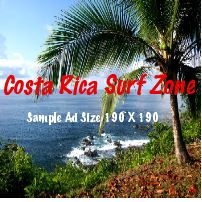Witch's Rock/Roca Bruja
Scroll Down for
|
View Untitled in a larger map |
Witch's Rock/Roca Bruja
Witch's Rock, or Roca Bruja, is located in the Santa Rosa National Park and is famous for the giant rock sitting just offshore around which swells break both left and right depending on the swell direction. Made famous in the 1994 "Endless Summer 2" surf film, it is a beachbreak known for very fast, hollow rights when there are big south/southwest swells. With smaller swells and more southerly swell direction Witch's Rock can also produce a good left break as well. Because of it's remote and difficult to access location, Witch's Rock is a generally uncrowded break. It is, however, somewhat fickle. If you are going to plan a trip for the day check the wave reports. It is a long ride by car and an expensive boat ride to be skunked.
Witch's Rock breaks better at medium tide and should be avoided at low tide. At low tide it has a tendency to wall up too much and close out. As at pretty much all Guanacaste beaches, offshore winds blow from the mountains to the east across flat lands during the Costa Rica summers, December through March but the swells are better during the Costa Rican winters - April through November. A northeast wind is best.
Getting There
Witch's Rock can be accessed by either car or boat. If you plan to drive there it is located 22 miles north of Liberia off the Interamerican Highway. Look for signs. The entrance is fairly clearly marked. A boat ride from Playa del Coco or Tamarindo is the best way to enjoy a day trip. There are a range of charters available depending on your needs or desires, from an inflatable for 5 at about $320 or $280 with no frills to a comfortable charter/fishing boat that includes food and drinks. Like Ollie's Point, Witch's Rock is one of those breaks that you will want to do your homework regarding swell, swell direction, swell size, and period before shelling out the cash for a ride.
You can check out the surf report for Ollie's at:
http://magicseaweed.com/Witches-Rock-Playa-Naranjo-Surf-Report/443/
About Santa Rosa National Park
Santa Rosa National Park was established in 1971 and is one of Costa Rica's oldest and largest parks. The park protects Central America's largest remaining area of tropical dry forests and encompasses an area of 91, 926 acres and is similar to the African savannah. The variety of species that reside within the park's borders is enormous and includes 115 mammal species, 60 species of bats, more than 4000 butterfly and moth species, and more than 250 species of birds. If you spend a little in the park, with your eyes open, ypu might encounter coyotes, coatimundis, peccaries, monkeys and a spectacular collection of birds. It is also home to the Olive Ridley turtle nesting site for more than 1,000,000 turtles that lay more than 11,000,000 eggs each season!
Spending Time in Santa Rosa
There are no hotels, or restaurants located in the Santa Rosa National Park but camping is a wonderful way to spend some time at this jewel of Costa Rica. There is a camping area located in the Sector Santa Elena in the central area of the park. It offers picnic tables, grills, restrooms, and showers, however, there is no potable water (There is potable water at the Sector Santa Rosa but it about a mile walk down the beach to the Witch's Rock surfing area). You must bring all the supplies that you will need for your stay. There is no store of any kind and it is a long drive into the park to the camping area. During the summer months (in Costa Rica that is December through March) getting there by car is not a big issue, but during the rainy season, now referred to as "the green season", a 4X4 is essential. The park's main entrance is 22 miles north of Liberia. Follow the signs on the Interamerican Highway.
Park Fees
There is a $10 per person entrance fee when you enter the park. You should find a park map at the entrance and then continue 3.5 miles to the park administration building. There you can check on road and weather conditions and pay$2 per person for camping permits.
Contacting the Park
It is a good idea to contact the park ahead of time. The contact number is: 2666-5051

